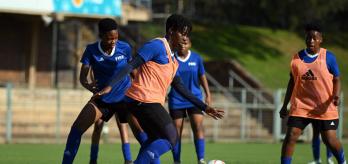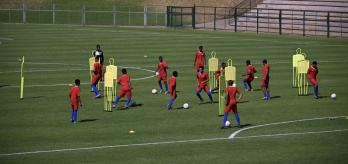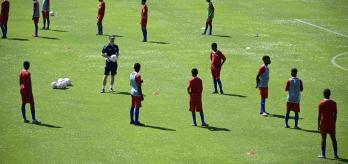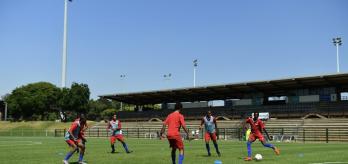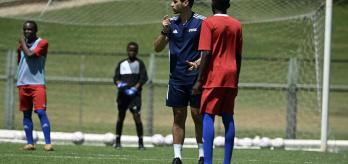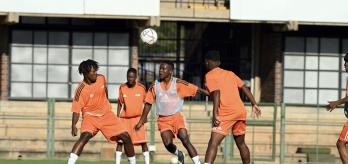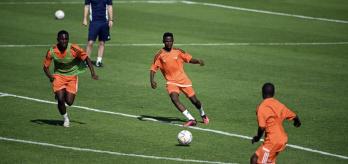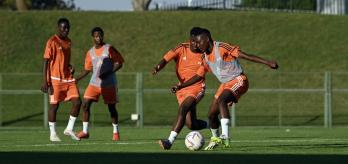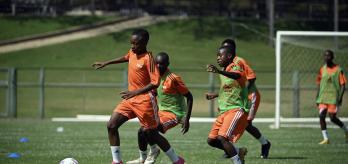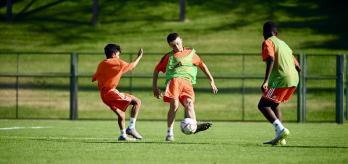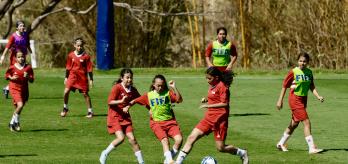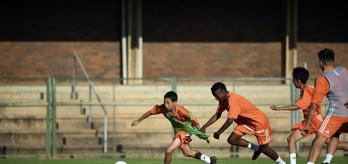Methodology
The intention: What is practised?
The main objective of these possession games is to identify opportunities to effectively build and progress the ball while maintaining possession. Both games emphasise unit and player actions that help to effectively break lines. In attack, the focus is on decision-making and identifying whether it is better to play a secure pass to retain possession or to play a penetrative forward pass. From a defensive perspective, blocking and preventing the in-possession team’s forward passes are the key elements. Both possession games resemble a build-up scenario with one player operating outside of the opposition’s team shape trying to progress forward through a vertical channel.
The scale: For whom is this relevant?
These possession games place a strong emphasis on both individual player skills and unit coordination. The game set-up mirrors the structure of a team during build-up, with one player taking on the role of a center-back, positioned just ahead of the pressing line. Another player, typically a number 6 or 8, positions themselves strategically to receive the ball inside of the opposition's formation. Lastly, a forward player is positioned at the opposite end, acting as a target for passes. Additionally, the smaller game format also requires wide players, creating the additional option to play around the opposition. By assigning players to specific roles, these games can be tailored to focus on developing position-specific skills.
The practice type: How is the practice designed?
Both games are specifically designed to offer players numerous opportunities to identify forward passing options. The overall objective of these scenarios is to enhance players’ understanding of when and how to break the oppositions first line of defence. The positioning of players in these games deliberately mirrors typical roles during the build-up phase. Furthermore, both games place a strong emphasis on vertical progression, rewarding players with a point for successfully progressing the ball while operating in a condensed area with limited time and space.
Session plan
Organisation
-
Mark out a 15x10m exercise area.
-
Divide the players into 3 teams: 2 blue players, 2 orange players and 3 green players (neutrals).
-
Position 1 blue player on the outside of either side of the exercise area.
-
Position 1 green player, who represents a goalkeeper, on the outside at either end of the exercise area.
-
Position 1 green player and 2 orange players inside the exercise area.
Explanation
-
The ball starts with 1 of the green players at the end of the area.
-
The green team must try to progress the ball from one end to the other by using the green player inside the area and the 2 blue players.
-
A point is awarded every time the in-possession team progress the ball from one end of the exercise area to the other.
-
If the orange team manage to win the ball, they must immediately connect with a green player positioned at either end of the exercise area to swap roles with the blue team and become the in-possession team.
-
Rotate the players so that they all have the opportunity to play in the middle.
Variation
-
Add a level of complexity by only awarding a point when the team reach the opposite end of the exercise area by playing through the player in the middle.
Organisation
-
Mark out a 20x10m exercise area.
-
Divide the exercise area into thirds (2 end zones and 1 central zone).
-
Divide the players into 3 teams: 4 blue players, 4 orange players and 3 green players (neutrals).
-
Position 1 green player inside each zone.
-
Set up 1 orange player v. 1 blue player in each end zone.
-
Set up 2 orange players v. 2 blue players in the central zone.
Explanation
-
The exercise starts with one of the green players at either end of the exercise area in possession.
-
The in-possession team’s objective is to progress the ball from one end of the exercise area to the other with the help of the neutral players.
-
All players are restricted to their zones.
-
The in-possession team should look to create 2v1 and 3v2 overloads in each zone with a view to progressing the ball.
-
The out-of-possession team try to win the ball back before using the green players to create overloads to progress the ball.
Key coaching points
Roles of coaches
-
First coach: starts the session off by reminding the players of the key actions and movements involved in receiving between the lines. Observes the two exercises.
-
Second coach: instructs the players in the 2v2+3 game and encourages defensive scenarios, such as controlling space and identifying triggers to press the ball.
-
Third coach: instructs the players in the 4v4+3 game and focuses on the players’ actions when offering to receive the ball.

























